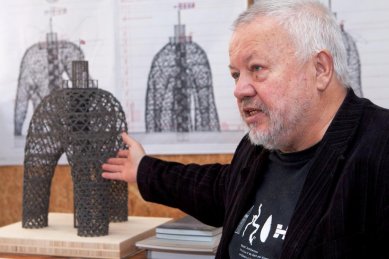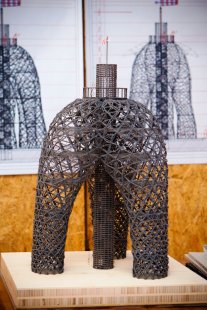
<Nad Rokytkou v Praze 14> could see the construction of a lookout tower by Rajniš
Prague - A new lookout tower could rise in Nad Rokytkou in Prague 14. The wooden structure is set to measure nearly 22 meters and was designed by the well-known architect Martin Rajniš, recognized as the author of the new Post Office on Sněžka. This was communicated to ČTK by Veronika Berná on behalf of the Prague 14 municipal office. The architect wants to verify the structural elements, so he will build a smaller tower from opportunistic trees with students on the shore of Kyjský pond.
"I perceive the lookout tower as a landmark that is currently missing in our district. Therefore, we decided to collaborate with architect Rajniš, who is known for his bold approach and the use of natural materials," said the mayor of the district, Radek Vondra.
The municipal office wants to position the lookout tower, which has the working title Doubravka, in the new leisure area Na Čihadlech above Rokytka. However, they still intend to discuss the plan with local residents.
A smaller test structure will be built this Sunday on the shore of Kyjský pond by a group of twenty students from three architectural faculties. It will measure 12 meters and will be made from opportunistic trees. On Sunday, people will also be able to view the designs for Doubravka.
Martin Rajniš (70) graduated from the Czech Technical University and the Academy of Art. In the 1970s, he worked in the SIAL studio led by Karel Hubáček. Together with John Eisler and Miroslav Masák, he built the Prague department store Máj on Národní Street. He is co-author of the pavilion of transportation history at Expo 1986 in Vancouver. After the revolution, he led D. A. Studio alongside Stanislav Fiala, Jaroslav Zima, and Tomáš Prouza, whose most extensive work is the construction of the new shopping center in Prague's Smíchov.
Since 2002, his work has taken a different direction. He focuses on smaller buildings made from natural materials. He strives to find ways that, with minimal resources and respect for the already existing buildings and landscape, can serve the widest possible group of users and restore architecture's key position in civilization.
"I perceive the lookout tower as a landmark that is currently missing in our district. Therefore, we decided to collaborate with architect Rajniš, who is known for his bold approach and the use of natural materials," said the mayor of the district, Radek Vondra.
The municipal office wants to position the lookout tower, which has the working title Doubravka, in the new leisure area Na Čihadlech above Rokytka. However, they still intend to discuss the plan with local residents.
A smaller test structure will be built this Sunday on the shore of Kyjský pond by a group of twenty students from three architectural faculties. It will measure 12 meters and will be made from opportunistic trees. On Sunday, people will also be able to view the designs for Doubravka.
Martin Rajniš (70) graduated from the Czech Technical University and the Academy of Art. In the 1970s, he worked in the SIAL studio led by Karel Hubáček. Together with John Eisler and Miroslav Masák, he built the Prague department store Máj on Národní Street. He is co-author of the pavilion of transportation history at Expo 1986 in Vancouver. After the revolution, he led D. A. Studio alongside Stanislav Fiala, Jaroslav Zima, and Tomáš Prouza, whose most extensive work is the construction of the new shopping center in Prague's Smíchov.
Since 2002, his work has taken a different direction. He focuses on smaller buildings made from natural materials. He strives to find ways that, with minimal resources and respect for the already existing buildings and landscape, can serve the widest possible group of users and restore architecture's key position in civilization.
The English translation is powered by AI tool. Switch to Czech to view the original text source.


0 comments
add comment
Related articles
0
17.05.2017 | The construction of the Doubravka XIV lookout tower designed by the Architecture Foundry is beginning
0
04.06.2014 | In the park in Prague 14, a new lookout tower will be built according to Rajniš's project
0
13.05.2014 | Artifact - invitation to participate in a workshop with Martin Rajniš







